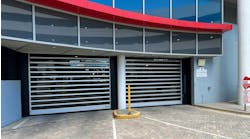The enormous toll of extreme weather events is difficult to witness and underscores the need for electricity in the most extraordinary circumstances. Building energy infrastructure must be resilient and able to withstand extreme conditions, especially as we rely on electricity to energize everything.
Energy resilience is about business continuity, and it enables operational resilience. There are proven ways to achieve it. Microgrids are progressively being used to keep the power on, even in the face of extreme weather. They also provide a path to increase sustainability and address rising energy costs by incorporating clean energy resources and intelligent controls.
Why microgrids? Because when your building also serves as your utility grid, it’s easier to keep the power on for critical processes. Microgrids help prepare for the unexpected by balancing where, when and how electricity is used.
A large part of resilience is the ability to adapt to change. As your power demands evolve, microgrids can provide a flexible and relatively fast solution to increase electrical capacity and defer costly utility grid upgrades that could take years to happen.
The biggest barrier to achieving more resilient energy infrastructure in buildings is figuring out where to start. Based on years of experience helping keep the power on, we at Eaton believe there are seven key steps to keep the power on.
1. Determine How Resilient You Need to Be
To ensure uptime, you need to first establish the value of resilience. This involves quantifying both the cost of power disruptions and the probability of them occurring. Essentially, it’s about taking stock of the “pain” from an outage.
The cost of a power disruption can be measured by its community impact, lost revenue and expenses, along with increased greenhouse gas emissions. You also need to establish the baseline for the likelihood, duration and anticipated impact of power outages. You can do this by factoring in the local environment, anticipated impact of extreme weather events, aging infrastructure and changing energy habits that could cause power disruptions.
2. Assess What’s Feasible
A feasibility study can help you see if the economics for a microgrid make business sense. This analysis looks at the risks and requirements for your energy system and provides opportunities to manage costs and even deliver additional value from your energy assets.
With energy systems and needs changing fast, a feasibility study can help chart the course to optimize your energy system today and into the future. Engaging with experts in power system design can help you create a modular approach, so you can build out the energy system you need over time—accommodating increasing electricity usage building systems and vehicle charging as you need it, planning for how to reduce emission to meet your energy goals, and finding opportunities to control utility bills in the face of increasing energy prices.
Depending on where you are located, microgrid systems often qualify for various incentives that help reduce costs (if you own your system): utility net metering rules allowing you to sell energy back to the grid; federal, state and local programs; as well as tax incentives.
How do you figure out what’s available and applicable? Partner with an expert who has boots on the ground and experience building and maintaining electrical infrastructure in your area. A microgrid feasibility study helps you understand how to chart your path forward.
3. Pick the Financing Model that Works For You
There are two basic models to finance microgrid systems and other distributed energy resource (DER) integration projects like battery energy storage: direct purchase or power purchase agreement. Each approach has its own unique benefits and purpose:
Direct purchase is what it sounds like, with the site owner buying the system from a solutions provider. The solutions provider is typically contracted to provide engineering, installation services and support for operations and maintenance.
Power purchase agreements (PPAs) are provided under an energy-as-a-service model, where you pay a set electricity rate to a solutions provider or financier that is based on the output and performance of the microgrid system. This allows you to lock in a set energy rate over a prescribed amount of time, resulting in more predictable energy costs in the face of steadily rising utility rates.
The PPA or energy-as-a-service model doesn’t require upfront capital, making microgrids more attainable for many customers by shifting the investment from a capital to an operational expense. This model guarantees set energy costs for the term of the contract, assures microgrid performance and covers ongoing maintenance costs. Ultimately, you should evaluate what makes the most sense for your building energy needs and exploring both financing models is important.
4. Evaluate Your On-Site Resources
Planning for resilience leverages all the tools you have at hand, and does not necessarily require rebuilding your energy systems, often it expands upon it. Early in the process of figuring how to meet your energy needs, it’s important to leverage energy sources you already have in place and plan for what you’ll need to support resilience into the future. This is typically part of the microgrid feasibility study.
Whatever energy sources you have today and plan to add in the years to come, these can all be used to keep the power on. You may already have emergency power resources sitting in reserve; generators and uninterruptible power supplies are typical and can help provide some level of resilience in the short term. Onsite renewable sources can typically support resilience for a longer duration. Remember, microgrid systems are flexible, and if you plan ahead, you can always add the resources you need over time.
5. Get Control to Optimize Your Energy Resources
A microgrid controller is the brains of the operation. It provides the ability to both operate independently when islanded from the grid and optimize on-site energy system needs when grid connected. This is an essential capability for resilience, balancing energy needs and the resources at hand to optimize energy usage and help you get the most out of your power infrastructure.
Your controller is what will kick in on-site generation sources to pick up building energy loads when the grid is down. And the controller can be integrated right into your building’s foundational electrical equipment—the switchboard—or be a standalone controller.
The controller automates energy generation and consumption decisions in your building by executing the most cost-effective and resilient strategy. This allows your on-site resources to keep the power flowing for as long as possible during an outage and drives efficiency when grid connected.
6. Simulate, If You Need To
How do you know that your microgrid will perform before you build it? Creating a digital twin or hardware-in-the-loop simulation provides confidence in the microgrid design by validating and optimizing performance before you build the system.
This powerful tool shows how your microgrid will work even under extreme conditions that you simulate and helps inform how the system should be optimally configured based on your use case and building needs.
7. Monetize Your Energy System
Lastly, expanding your building’s energy resilience by adding flexible energy assets also opens up new potential revenue streams from those power infrastructure investments. Microgrids create monetization opportunities from your energy assets, allowing you to shift to your on-site generation during peak demand when utility prices are highest.
Depending on where you are located and the available local utility programs, you may also be able to sell excess power to the utility in the form of grid services to support frequency regulation, participate in demand response programs and more. This capability both lowers your energy costs and benefits your community by lowering your building’s power demand on the local grid at peak times.
Creating Energy Systems That Work for You Today and Into the Future
Power interruptions from extreme weather events are more frequent. Energy costs are increasing. And the need to decarbonize is more and more important. Microgrids provide an essential function—keeping the power on, while helping manage energy costs and accelerating clean energy systems.
Every building is unique, and your energy resilience must be tailored to your needs. For that reason, it’s important to take stock and act now to put the power in your own hands – keep the power on for your site through storms and grid disruptions, control your costs even as energy costs increase, and deliver on your decarbonization goals. A microgrid will help make sure your building energy needs are met more reliably, affordably and sustainably.
About the Author:
Greta Foster is the distributed energy resources product line manager for Engineering Services at Eaton. She has responsibility for shaping Eaton's microgrid solutions portfolio.




